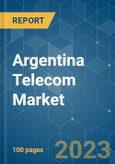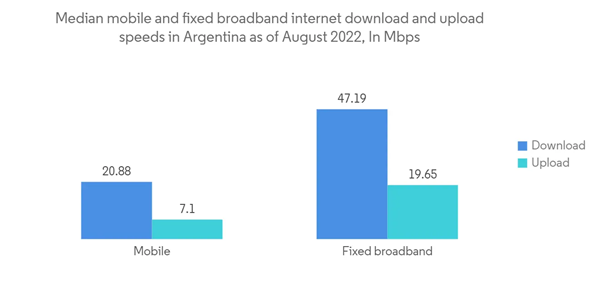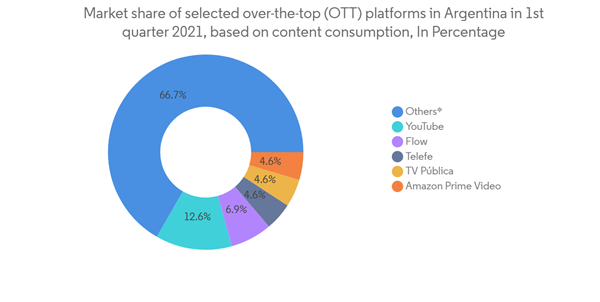Key Highlights
- With widespread LTE coverage and high levels of mobile adoption, mobile broadband is still the go-to method for accessing the Internet. The first 5G service was launched in February 2021 using re-farmed LTE frequencies. To increase government revenue and combat the country's high inflation, Argentina would hold a 5G spectrum auction in February 2023. Mobile broadband service adoption is expected to increase more due to the next 5G spectrum auctions.
- According to the president of industry regulator Ente Nacional de Comunicaciones (ENACOM) (the National Communications Entity), the Argentine government is optimistic that the 5G spectrum auction scheduled for the first quarter of 2023 will succeed. The government is actively working to improve Internet access across the nation, even as different fixed, mobile, and cable companies fight to increase and enhance their offerings. Plan Conectar, its national connectivity strategy, which was unveiled in September2020, provides funding for a number of coverage-improving initiatives.
- While several fixed, mobile, and cable companies work to increase and improve their services, the government is also actively promoting broadband access across the nation. The forecast period is expected to witness a rise in fixed broadband revenue, driven by rising broadband penetration and rising aggregate broadband average revenue per user (ARPU). According to ENACOM, Argentina's fixed-line internet income reached its high in 2021, at around ARS 163.4 billion (USD 1.01). Compared to 2019, fixed-line internet revenue increased nearly two times in 2021.
- The government of Argentina implemented price freezes on more than a thousand consumer items last month to slow the rise in the cost of living, which caused annual inflation to soar. Since 2020, the COVID-19 pandemic and rising costs have worsened the nation's economic problems. The ongoing hyperinflation in Argentina continues to impact the performance of the telecom business. It exhibits substantial revenue increase but just slight annual subscription growth.
- When the COVID-19 epidemic first struck in 2020, Argentina had already entered a recession. However, the nation has been witnessing a stunning turnaround, with a 10.2% increase in GDP in 2021, following three years in a row of economic contraction. Just when the nation rebounded from the pandemic's effects, it started dealing with rampant inflation and declining financial credibility. Prices of commodities have risen more than anticipated, mostly due to high demand, thereby causing a reduction in purchasing power of people.
Argentina Telecom Market Trends
Robust Internet Coverage
- In Argentina, people have unrestricted access to the internet and can interact freely on social media. Argentina has one of the highest internet penetrations in Latin America. In the early months of this year, the country had approximately 38 million internet users, and 83 % of Argentina's population used the internet, according to Kepio's research. Between the last and current years, there was an increase of 1.7 million (+4.7%) internet users in Argentina. The number of people connected to the internet is predicted to reach 42 million users by the end of the forecast period.
- In the first quarter of the current year, there were 7.84 million fixed-line internet subscribers, up 2% from the previous quarter. During the same time, 34.78 million mobile internet users were up 9.9% from the prior year. Only 17% of all fixed-line internet connections in Argentina as of late last year are fiber-optic, according to data from the Argentine Internet Chamber (CABASE). In June last year, 73% of all Argentina's connections had speeds greater than six megabits per second (Mbps); 55% had speeds greater than 20 Mbps; 7% had speeds between 10 and 20 Mbps, and 11% had speeds between 6 and 10 Mbps.
- A sum of USD 100 million has been authorized by the Inter-American Development Bank (IDB) for a program to support internet access and digitization in Argentina. The operation's objective is to expand the National Data Center's capacity, enhance digital capabilities for residents in linked regions, and enhance digital connectivity infrastructure in remote places. Notably, the Program for the Development of the Federal Fiber Optic Network (REFEFO) would also be funding the extension and outfitting of infrastructure to connect 258 rural locations with fiber optics.
- Since the pandemic began, the internet has shown to be a vital instrument for the population's production, employment, and education. According to a recent study, two out of every three families in metropolitan conglomerations in Argentina have at least one computer, and nine out of ten of these homes have Internet connectivity. At the same time, internet usage is expanding in Argentina. More than 70% of the population in the South American nation is believed to have internet connectivity.
- Per the Speedtest report, the current year's download and upload speeds of fixed broadband internet in Argentina were faster than those of mobile. The median fixed broadband internet download speed at that time was 47.19 Mbps, while the upload speed was 19.65 Mbps.
Demand of OTT and SVOD
- Argentina's SVOD and OTT market has been booming since the arrival of Netflix at the end of 2011. Netflix and some minor players dominated the Argentina OTT and video streaming market. However, with the launch of Amazon Prime Video and the implementation of agreements with Pay TV providers, the market witnessed some competition. The entry of Disney's services (Disney+ and Star+) and HBO Max together changed the industry model last year.
- Considering the region's tremendous potential and developing market conditions, particularly in nations like Brazil, Argentina, and Mexico, several OTT and VOD providers are expanding there. Argentina is one of Latin America's smaller but fastest-growing OTT markets and has the highest internet penetration in Latin America. The media and entertainment sector has experienced significant development, which has sped up the creation of top-notch media content and supported market expansion in Argentina.
- Furthermore, the market is also being driven by consumers' shifting preferences for OTT platforms over historically popular cable and satellite television sets due to their increased convenience, higher connectivity, better accessibility, etc. Additionally, several OTT and SVOD service providers are continuously moving towards digital transformation and persistently applying artificial intelligence (AI) to assess user preferences and provide tailored content, enhancing the overall user experience.
- Business models must adapt to new technology. The Internet is now in our pockets, thanks to smartphones. With the increased use of smartphones in the country, OTT applications have significantly improved online conversations and interactions. Additionally, the COVID-19 epidemic has accelerated the digitization of daily life and business around the globe. The upsurge in the usage of OTT services platforms, such as Zoom, Skype, Messenger, and WhatsApp, for audio and video chats was most widely observed.
- According to Argentine Internet Chamber's report, 13% of Argentina's OTT content consumption was attributed to Netflix during the first three months of last year. Market share for YouTube and YouTube Premium as a whole was 14%. Similarly, at the start of last year, Netflix and YouTube had the highest usage rates among online households in Argentina.
Argentina Telecom Market Competitor Analysis
The Argentina telecom market is consolidated in nature. Some major players in the market studied include América Móvil (Claro), Telecom Argentina S.A., Telefonica De Argentina S.A. (Movistar), and Telecentro SA. The market also hosts other Internet service providers (ISPs), MVNOs, and fixed-line service providers.- In July 2022, ARSAT will expand satellite penetration in Argentina via SES-17. By utilizing SES-17's capacity, ARSAT would increase people's and companies' access to 'cheap and high-quality' satellite internet services. Additionally, as part of a deal with the Ministry of Education, ARSAT would provide an internet connection to public schools across the nation utilizing SES-17.
- In February 2022, Telefónica Movistar, in association with Red Hat Consulting, introduced Managed Cloud. Telefónica Movistar Argentina's business clients want increased flexibility, management, and cost-effectiveness. Red Hat Consulting contributed knowledge and provided a direct line to Red Hat Support, among other departments, products, and technologies.
Additional benefits of purchasing the report:
- The market estimate (ME) sheet in Excel format
- 3 months of analyst support
This product will be delivered within 2 business days.
Table of Contents
Companies Mentioned (Partial List)
A selection of companies mentioned in this report includes, but is not limited to:
- America Movil (Claro)
- Telecom Argentina S.A.
- Telefonica De Argentina SA (Movistar)
- Telecentro SA
- Telmex Argentina S.A.
- ARSAT










